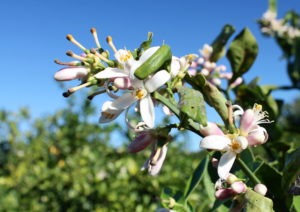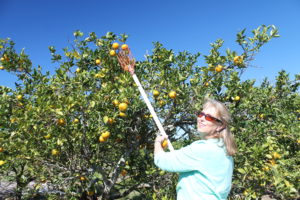Fruit-Growing That We Can’t Do
February 21st, 2017
Here in central Pennsylvania, we have our cherries, peaches, pears and apples. And glorious these tree fruits are as they tastily hand off to one another throughout summer.
While hiding out from winter last month in Florida, I had a chance to see a whole different kind of tree fruit in action – citrus.
Florida can’t do cherries, peaches, pears and apples because of the lack of winter chill time, but we can’t do oranges, grapefruits, tangerines and tangelos because they don’t like our little “inconvenience” called freeze.
Citrus is a fascinating crop, as I found out while touring a citrus farm in Polk County to the southwest of Disney World.
For one thing, most citrus crops – and especially oranges – hit peak harvest from December through March. That’s a time when our peaches and apples aren’t even thinking of flowering, much less fruiting.
But the most striking feature is the fragrance. The scent of an orange grove in flower is a scent to behold.
The perfume wafts over the whole grove, very similar to the sweet scent of gardenia (another worthy plant our freezes make all but impossible).
In some ways, growing citrus is similar to our tree-fruit-growing.
Citrus trees are small – generally under 18 feet – and like our tree fruits, they prefer lots of sun.
Citrus crops also come in many different varieties that vary in ripening time to help spread out the harvest.
An orange-grower, for example, might plant ‘Hamlin’ to get ripe fruits starting in October, then navels or varieties such as ‘Pineapple’ or ‘Midsweet’ for a January-to-March peak, and then ‘Valencia’ for March-to-July picking.
Ditto for tangerines. A popular variety called ‘Fallglow’ produces October through December, and then ‘Honey Tangerine’ picks up the slack from December through June.
Grapefruits generally ripen November through July, and lemons and key limes can churn out fairly continuous ripe fruits all year.
Also like our tree fruits, citrus can run into a rogue’s gallery of bugs and diseases.
The worst threat is a bacterial disease called citrus canker that spreads quickly and can ruin fruit and kill branches. Once it hits, farmers generally cut down the infected trees. Another bad one is citrus greening, which can kill whole groves.
Citrus also can be damaged by fungal diseases such as greasy spot and sooty mold and by a bug lineup that includes aphids, whiteflies, caterpillars, thrips, scale and mites.
That’s where the similarity ends.
One big difference is that citrus trees don’t need or want much pruning. Other than cutting off dead or damaged wood, citrus-growers don’t have to do the annual thinning and selective branch removal that increase our fruit sizes and reduce disease.
Another difference you’ll notice when getting up close and personal with a citrus tree, especially oranges: they have thorns.
Although some are thornless or nearly so, and some have fairly tiny thorns, others have weapons that give pyracantha a run for their gardener-puncturing talent.
The hot weather and sandy soil of Florida groveland also means irrigation is needed at least some of the time, particularly when trees are young.
Sandy soil doesn’t hold nutrients as well either, so that means citrus growers are advised to fertilize their trees three to four times a year and as often as six times a year when a tree is young.
When to pick is a big deal with most of our tree fruits. The trick is to pick when fully mature, or just before as in the case of peaches and pears, which continue to ripen and soften after being picked.
Pick too soon and the texture is hard and the taste not sweet. Pick even a few days too late, and the fruits already could be rotting on the branches.
Citrus is a little more forgiving. Although it doesn’t ripen after being picked, much of it can hang mature on the trees for weeks or even months before it drops and/or rots.
And although tangerines and tangelos need pollinators to yield, oranges and most other citrus are self-fruiting (meaning you could plant just one orange tree and get fruit).
No matter what fruit you’re picking and where, I’ve found that it’s hard to beat the taste when you’re eating right off the tree.
My wife, Sue, and I got a chance to do that at a pick-your-own citrus farm called Showcase of Citrus, and the fruits were better than any I’ve eaten from a northern grocery store.
Fruits on the trees might not look perfect (many had blemishes or surface discoloration), but the imperfections don’t seem to affect the delicious insides.
‘Honeybell’ (a.k.a. ‘Minneola’) is a particularly good choice for its super-sweet flavor, dark-orange rind, and distinctive pear-like shape. It’s a tangelo cross of a grapefruit and tangerine. No wonder Floridians clamor for ‘Honeybells’ as we drool over ‘Honeycrisp’ apples.
I also liked the red navel oranges… also very sweet and good-looking with its pink flesh.
And something I liked but never had before was a pumelo. These are big fruits about the size of softballs. They taste like sweet grapefruits.
I’ll still always look forward to south-central Pa. peaches and apples in summer, but I could get used to Florida ‘Honeybells’ and pumelos every winter, too… especially picking them fresh under a blue sky and 80-degree temperatures in January.










